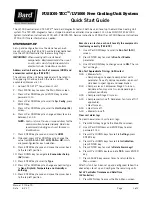
16
3. Set the thermostat above room temperature and
verify the sequence of operation. (See Operating
Sequence on page 25.)
4.
Verify that the compressor and outdoor fan motor
are not energized.
5.
After the unit has run for approximately fi ve minutes,
set the thermostat below room temperature and
verify the shutdown sequence. (See Operating
Sequence on page 25.)
Verifying and Adjusting Firing Rate —
The fi ring rate
must be verifi ed for each installation to prevent over-fi ring
of the furnace.
CAUTION:
Do not re-drill the burner orifi ces. If the orifi ce
size must be changed, use only new orifi ces.
IMPORTANT NOTE: The fi ring rate must not exceed
the rate shown on the unit data label. At altitudes
above 2,000 ft. it must not exceed that on the data
label less 4% for each 1,000 ft.
Follow the procedure below to determine the fi ring rate:
1.
Shut off all other gas fi red appliances.
2
Start the unit in heating mode and allow it to run
for at least three minutes.
3.
Measure the time (in seconds) required for the gas
meter to complete one revolution.
4.
Convert the time per revolution to cubic feet of gas
per hour using
Table 8
.
5.
Multiply the gas fl ow rate in cubic feet per hour by
the heating value of the gas in Btu per cubic foot
to obtain the fi ring rate in Btu per hour. Example:
a. Time for one revolution of a gas meter with a
one cubic foot dial = 40 seconds.
b. From
Table 8
read 90 cubic feet per hour of
gas.
c. Heating value of the gas (obtained from gas
supplier) = 1040 Btu per cubic foot.
d. Firing rate = 1040 x 90 = 93,600 Btuh.
6. Adjustments to the fi ring rate can be made by
adjusting the gas manifold pressure. See the High
Altitude Application section for additional information
of fi ring rate at elevations above 2000 ft.
The manifold pressure must be set to the appropriate value
for your installation. Refer to either
Table 5
for natural
gas or
Table 6
for LP/propane gas to verify the manifold
pressure setting required for your particular installation.
To adjust the manifold pressure, remove the regulator cap
and turn the adjusting screw clockwise to increase pres-
sure or counterclockwise to reduce pressure. Replace the
regulator cap after adjustments are complete.
• Verify that the thermostat is wired correctly. The
thermostat function switch should be set to “Off” and
the thermostat fan switch should be set to “Auto.”
WARNING:
If the unit is equipped with a crankcase heater,
allow 24 hours prior to continuing the start up
procedures to allow for heating of the refrigerant
compressor crankcase. Failure to comply may
result in damage and could cause premature
failure of the system. This warning should be
followed at initial start up and any time the power
has been removed for 12 hours or longer.
CAUTION:
This unit uses refrigerant R-410A. DO NOT
under any circumstances use any other
refrigerant besides R-410A in this unit. Use of
another refrigerant will damage this unit.
START-UP PROCEDURE
Close all electrical disconnects to energize the system.
Air Circulation —
Leave the thermostat system switch
set to “Off” and set the thermostat fan switch to “On.” The
blower motor should run continuously. Check for air delivery
at the register(s). Ensure that there are no obstructions at
the registers or in the ductwork. Set thermostat fan switch
to “Auto,” the blower will shut down in 60 seconds.
System Cooling
1. Set the thermostat system switch to “Cool” and
the thermostat fan switch to “Auto.” Gradually
lower the thermostat temperature switch below
room temperature and observe that the blower,
compressor and fan energize. Check that air cooler
than room temperature is being discharged at the
register. Listen for any unusual noises. Locate the
source and correct as needed.
2. After allowing the unit to run for several minutes, set
the temperature selector above room temperature,
verify that:
a. The fan and compressor cycle off with the
thermostat.
b. The blower also stops after the 85 second
delay.
System Heating
1.
Set the thermostat to the lowest setting.
2. Follow the procedures given on the operating
instruction label, in this installation instructions
or attached inside the louvered control access
panel.






























